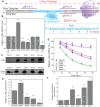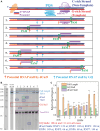Combining CRISPR activation and interference capabilities using dCas9 and G-quadruplex structures
- PMID: 39906285
- PMCID: PMC11788920
- DOI: 10.1093/narmme/ugaf001
Combining CRISPR activation and interference capabilities using dCas9 and G-quadruplex structures
Abstract
We demonstrate that both Clustered regularly interspaced short palindromic repeats (CRISPR) interference and CRISPR activation can be achieved at RNA and protein levels by targeting the vicinity of a putative G-quadruplex (GQ)-forming sequence (PQS) in the c-Myc promoter with nuclease-dead Cas9 (dCas9). The achieved suppression and activation in Burkitt's Lymphoma cell line and in in vitro studies are at or beyond those reported with alternative approaches. When the template strand (contains the PQS) was targeted with CRISPR-dCas9, the GQ was destabilized and c-Myc mRNA and protein levels increased by 2.1- and 1.6-fold, respectively, compared to controls in the absence of CRISPR-dCas9. Targeting individual sites in the nontemplate strand (NTS) with CRISPR-dCas9 reduced both the c-Myc mRNA and protein levels (by 1.8- and 2.5-fold, respectively), while targeting two sites simultaneously further suppressed both the mRNA (by 3.6-fold) and protein (by 9.8-fold) levels. These were consistent with cell viability assays when single or dual sites in the NTS were targeted (1.7- and 4.7-fold reduction in viability, respectively). We also report extensive in vitro biophysical studies which are in quantitative agreement with these cellular studies and provide important mechanistic details about how the transcription is modulated via the interactions of RNA polymerase, CRISPR-dCas9, and the GQ.
© The Author(s) 2024. Published by Oxford University Press on behalf of NAR Molecular Medicine.
Conflict of interest statement
None declared.
Figures






Update of
-
Combining the CRISPR Activation and Interference Capabilities Using dCas9 and G-Quadruplex Structures.bioRxiv [Preprint]. 2024 Nov 20:2024.11.19.624357. doi: 10.1101/2024.11.19.624357. bioRxiv. 2024. Update in: NAR Mol Med. 2025 Jan 28;2(1):ugaf001. doi: 10.1093/narmme/ugaf001. PMID: 39605509 Free PMC article. Updated. Preprint.
References
Grants and funding
LinkOut - more resources
Full Text Sources
